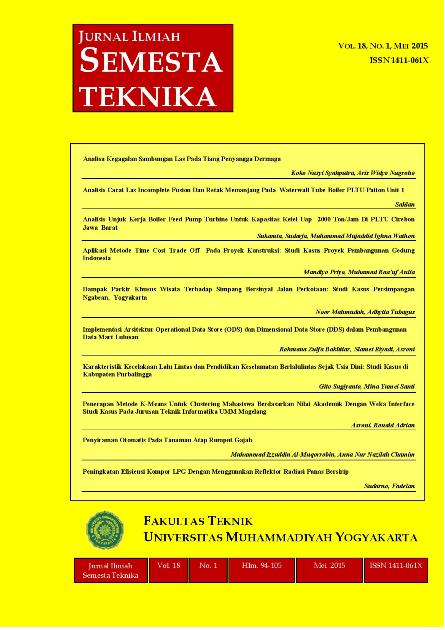Implementasi Arsitektur Operational Data Store (ODS) dan Dimensional Data Store (DDS) dalam Pembangunan Data Mart Lulusan
DOI:
https://doi.org/10.18196/st.v18i1.706Keywords:
data mart, Operational Data Store, Dimensional Data Store, data storage, accreditation formAbstract
Universitas Muhammadiyah Yogyakarta (UMY) is a big and high-grade educational institution. During the period of 1998-2014, UMY has produced about 20550 graduates. But, the big number of graduates is not supported by a good data storage system. Whereas those data are needed in filling up the accreditation form. For that reason, we have to build an integrated data storage system to provide graduates data as needed, that is graduate data mart. The development of graduate data mart uses SDLC Model Waterfall method. This method involves several types, there are requirement analysis, design system, implementation system, testing system, and maintenance system and those must be done sequentially. If there is an error, the process must be repeated from the beginning to fix the error. Development of graduate data mart uses Operational Data Store (ODS) and Dimensional Data Store (DDS) architecture. Those architectures are selected because they support transactional level. By using those architectures, graduate data mart is capable to display the data of graduates on the academic year, GPA, educational years, and the status of the student transfers. As the result, those data are able to help the management of university in filling up the accreditation form.
Downloads
Published
How to Cite
Issue
Section
License
Semesta Teknika is licensed under a Creative Commons Attribution 4.0 International License.
Authors who publish with this journal agree to the following terms:
- Authors retain copyright and grant the journal right of first publication with the work simultaneously licensed under a Creative Commons Attribution License that allows others to share the work with an acknowledgement of the work's authorship and initial publication in this journal.
- Authors are able to enter into separate, additional contractual arrangements for the non-exclusive distribution of the journal's published version of the work (e.g., post it to an institutional repository or publish it in a book), with an acknowledgement of its initial publication in this journal.
- Authors are permitted and encouraged to post their work online (e.g., in institutional repositories or on their website) prior to and during the submission process, as it can lead to productive exchanges, as well as earlier and greater citation of published work (See The Effect of Open Access).









